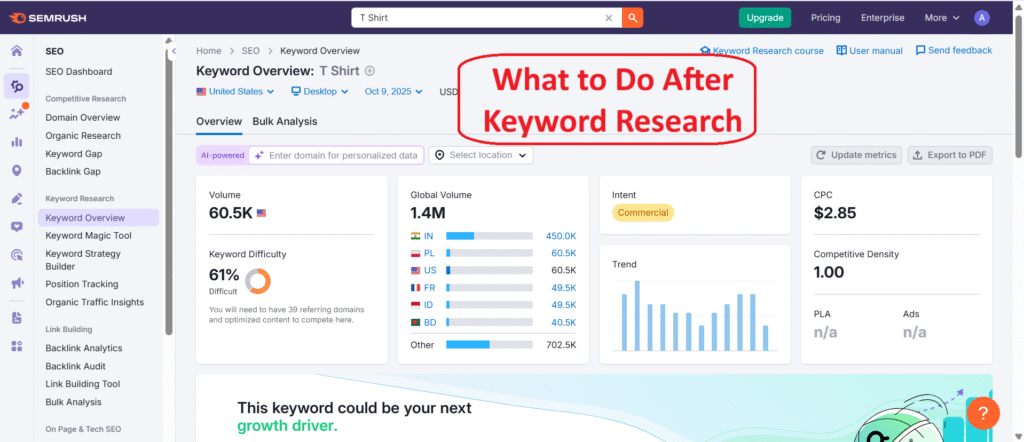

What to Do After Keyword Research — that’s the big question every SEO beginner and marketer faces once they’ve compiled their keyword list. You might have used tools like Ahrefs, SEMrush, or Ubersuggest to uncover high-potential search terms, but unless you act strategically afterward, those keywords will remain nothing more than data points.
The real magic begins after keyword research — when you turn insights into content, traffic, and conversions. In this comprehensive guide, we’ll cover 10 proven steps to make your post-keyword research strategy more powerful, practical, and profitable.
‘’Content is the atomic particle of all digital marketing.’’
Once you’ve gathered dozens or hundreds of keywords, it’s time to organize them. Random lists don’t drive results — structured ones do.
Segment keywords by intent: Identify if users are seeking information (informational), comparing options (navigational), or ready to buy (transactional).
Filter by difficulty and search volume: Choose a mix of low, medium, and high competition keywords.
Remove irrelevant ones: Eliminate keywords that don’t match your product, service, or audience.
Prioritize based on business goals: Focus on the ones most likely to attract your target customers.
This step ensures your SEO efforts stay focused and achievable.
A common mistake is trying to target every keyword with one blog post. Instead, map each keyword (or keyword cluster) to a suitable content type:
Blog posts / articles: Perfect for “how-to” or “what is” queries.
Landing pages: Best for high-intent, product-related keywords.
Category pages: For e-commerce or directory-based websites.
FAQs and guides: Ideal for long-tail, question-based keywords.
For example, if your keyword is “best SEO tools for beginners,” a comparison article or listicle fits perfectly.
By mapping keywords strategically, you make your site structure SEO-friendly and avoid keyword cannibalization.
Once you know your keywords and their matching content types, build a keyword content plan. This acts as your SEO roadmap.
Include:
Target keyword (primary + secondary)
Content title and outline
Search intent
Publishing date
Internal linking targets
This plan ensures consistency, focus, and direction. You’ll always know what to publish next and how it contributes to your SEO growth.
Your title is the first impression users get from search results. Make it catchy and include your main keyword once — just like this post’s title: “10 Proven Steps on What to Do After Keyword Research for Massive SEO Growth.”
Tips for crafting titles and descriptions:
Use numbers, emotional triggers, or power words (e.g., “proven,” “ultimate,” “effective”).
Keep title length under 60 characters for better SERP display.
Add a benefit or result (like “boost traffic” or “grow SEO fast”).
Write unique meta descriptions (under 155 characters) summarizing the content.
Example meta description:
Discover what to do after keyword research with these 10 proven SEO steps to boost your traffic and rankings.
Once your structure is ready, it’s time to write — but write for humans first, search engines second.
Your goal should be to educate, solve problems, and engage readers. Search engines reward helpful content.
Best writing practices:
Use the focus keyword naturally — not more than 12 times.
Add synonyms like “post-keyword research strategy”, “after keyword analysis”, “keyword action plan”.
Keep sentences short and clear.
Add examples, real data, and screenshots.
Use H2 and H3 headings for structure.
Write at least 1,500–2,000 words for in-depth coverage.
Your readers should feel they’ve learned something valuable — not just skimmed fluff.
Even the best-written content needs optimization to rank.
Here’s your quick checklist:
✅ Use one H1 tag (your main title).
✅ Include primary keyword in first 100 words, and once in conclusion.
✅ Add related keywords in headings and subheadings.
✅ Optimize image alt tags with descriptive text.
✅ Use short, readable URLs like /what-to-do-after-keyword-research.
✅ Add internal links to other posts and external links to authority sources.
✅ Write SEO-friendly meta tags and ensure proper keyword density (around 1–1.5%).
Doing this helps Google understand your content and rank it for the right search terms.
Visual content makes your article more engaging and improves dwell time (a key SEO metric).
You can include:
Infographics summarizing keyword workflow.
Screenshots of SEO tools like Ahrefs, SEMrush, or Google Trends.
Comparison tables (e.g., keyword difficulty vs. volume).
Short explainer videos or animations.
Compress all images for faster page speed and add descriptive alt text using related terms like “after keyword research steps” or “post-SEO strategy visuals.”
Before hitting “publish,” make sure your article is technically optimized.
Test page speed: Use Google PageSpeed Insights or GTmetrix.
Ensure mobile responsiveness: Most visitors will come from mobile devices.
Fix broken links: They hurt SEO and user trust.
Add canonical tags if similar content exists.
Enable HTTPS for site security.
Use schema markup (FAQ or HowTo) for rich snippets.
A technically sound website gives Google confidence to index your pages faster and higher.
Once published, don’t just wait for organic traffic — promote it!
Here are some smart strategies:
Share on social media: Facebook, LinkedIn, X (Twitter), Pinterest.
Join communities: Answer questions on Quora or Reddit and link back to your article.
Email your subscribers: Use a catchy subject like “10 Smart Things to Do After Keyword Research.”
Create short video summaries for YouTube or Reels.
Reach out to bloggers or webmasters for backlinks.
Consistent promotion amplifies visibility, builds authority, and drives faster SEO results.
SEO is not a one-time job — it’s continuous improvement.
After publishing, track your content’s performance:
Use Google Search Console to monitor impressions, CTR, and rankings.
Use Google Analytics to check page views, session time, and bounce rate.
Update your article periodically with new statistics or trends.
Re-optimize underperforming posts by refreshing headlines or adding more internal links.
With time, your article will climb up the SERPs and bring consistent organic traffic.
If you’ve followed these steps but still struggle to get results, consider outsourcing to an SEO specialist. You can hire a professional to conduct keyword research, competitor analysis, and on-page SEO optimization — ensuring your content gets the attention it deserves.
👉 Need expert help? Check out my Fiverr gig where I offer keyword research and SEO optimization services to boost your online visibility and organic traffic.
Visit My Fiverr Gig Here
AzadEye is a creative agency offering expert Web Design, Development, SEO, and Digital Marketing services. We help businesses grow online with smart strategies and stunning digital solutions.
Copyright © 2025 azadeye.com All Rights Reserved.


Супер штука, буквально вчера копался по этому направлению:)